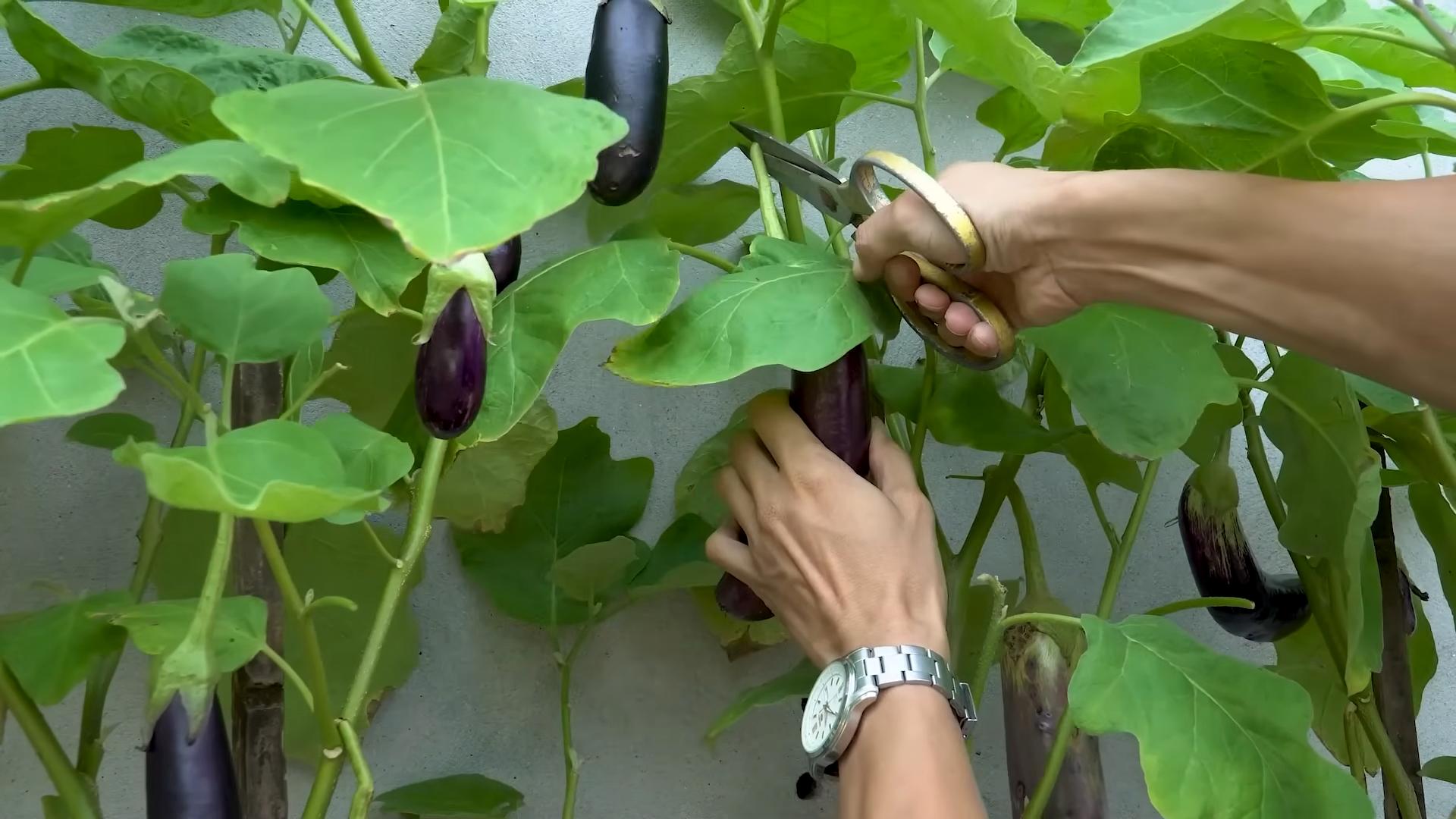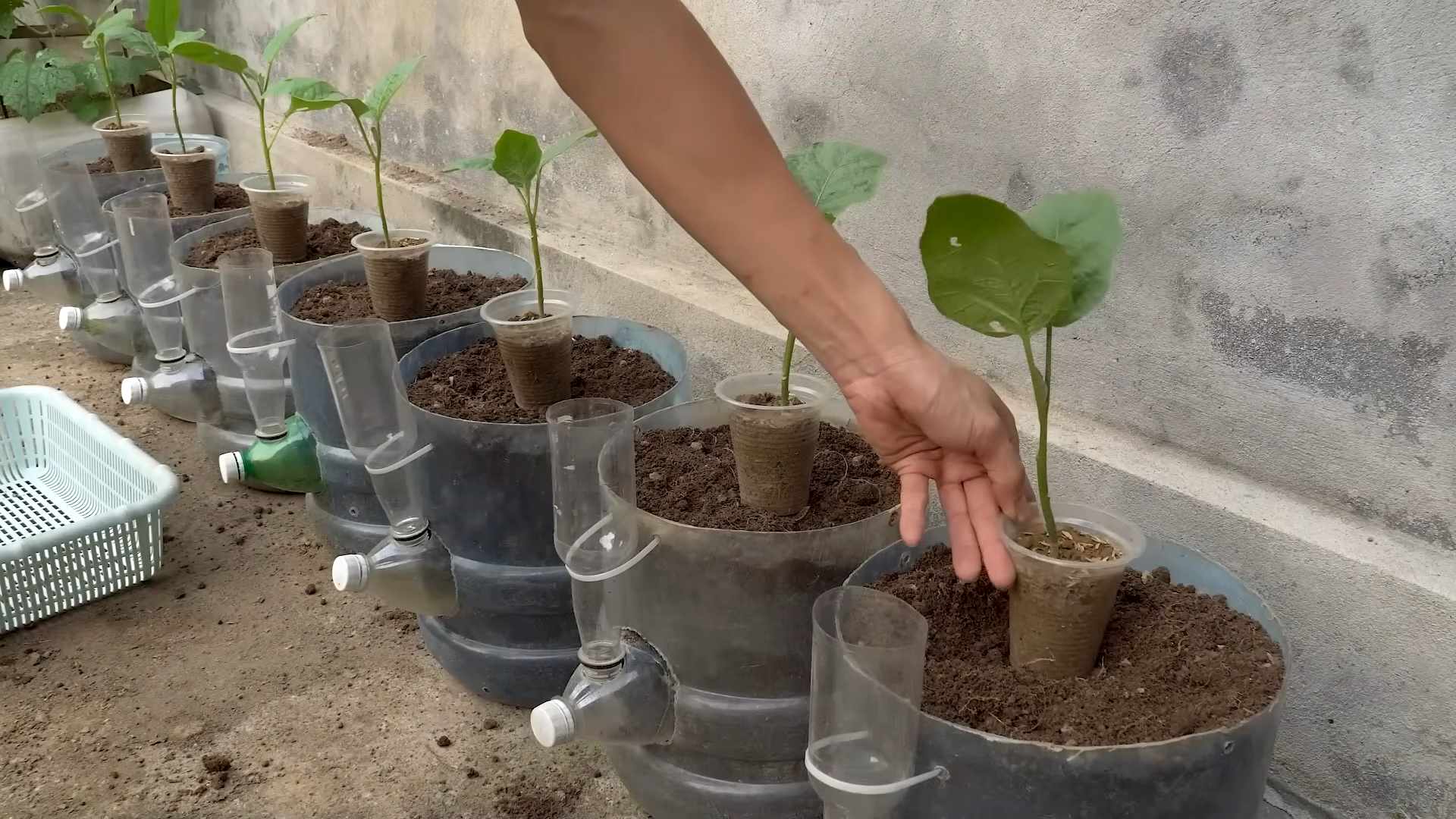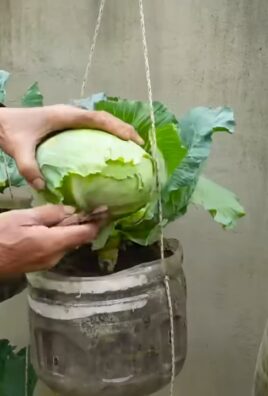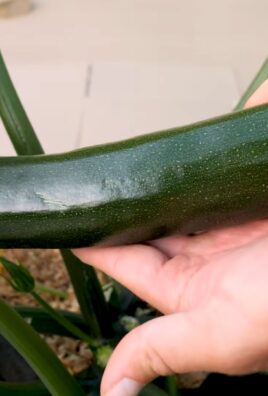Grow Eggplants Without a Garden? Absolutely! I know, it sounds a bit crazy, right? But trust me, you don’t need acres of land to enjoy the delicious, homegrown taste of fresh eggplants. This DIY guide is packed with simple, effective tricks to help you cultivate these beautiful purple vegetables, even if you’re living in an apartment with just a balcony or a small patio.
Eggplants, also known as aubergines, have a rich history, dating back thousands of years to ancient Asia. They were initially cultivated for their medicinal properties before becoming a culinary staple in various cultures around the world. From the Mediterranean’s moussaka to Asia’s flavorful curries, eggplants have proven their versatility and deliciousness.
But why bother with growing your own, especially if you don’t have a traditional garden? Well, for starters, the taste of a homegrown eggplant is simply unmatched. Plus, you have complete control over the growing process, ensuring that your eggplants are free from harmful pesticides and chemicals. In today’s world, where access to fresh, healthy food is more important than ever, learning how to grow eggplants without a garden is a game-changer. It’s a sustainable, rewarding, and surprisingly easy way to bring a little bit of nature into your life and enjoy the fruits (or rather, vegetables!) of your labor. So, let’s dive in and discover the secrets to successful container gardening and how you can grow eggplants without a garden!

Grow Eggplants Without a Garden: Container Gardening Guide
Hey there, fellow plant enthusiasts! So, you’re dreaming of delicious, homegrown eggplants but lack a traditional garden? No problem! I’m here to tell you that you can absolutely grow eggplants in containers, even if you only have a balcony, patio, or sunny windowsill. I’ve done it myself, and trust me, the satisfaction of harvesting your own plump, purple beauties is totally worth it. Let’s dive into how you can make this happen!
Choosing the Right Eggplant Variety
First things first, not all eggplants are created equal, especially when it comes to container gardening. You’ll want to choose a variety that’s naturally compact and well-suited for growing in pots. Here are a few of my favorites:
* Patio Baby: As the name suggests, this variety is perfect for patios! It produces small, glossy eggplants on compact plants.
* Fairy Tale: These eggplants are beautiful and delicious, with a mild flavor. The plants are relatively small and productive.
* Hansel: Similar to Fairy Tale, Hansel produces clusters of small, elongated eggplants.
* Little Fingers: This variety yields slender, finger-like eggplants that are great for grilling or stir-fries.
Remember to check the seed packet or plant label for information on the plant’s mature size. You want to avoid varieties that get excessively large, as they’ll quickly outgrow their containers.
Preparing Your Container and Soil
Okay, now that you’ve chosen your eggplant variety, let’s get your container ready. This is a crucial step, so pay close attention!
* Container Size: Eggplants need plenty of room for their roots to grow. I recommend using a container that’s at least 14-16 inches in diameter and 12-14 inches deep. The bigger, the better, really! A 5-gallon bucket works well, but even larger is preferable.
* Drainage: This is non-negotiable! Make sure your container has drainage holes at the bottom. Eggplants hate sitting in soggy soil, which can lead to root rot. If your container doesn’t have drainage holes, you’ll need to drill some.
* Soil: Forget garden soil! It’s too heavy and compacts easily in containers. Instead, use a high-quality potting mix specifically formulated for containers. Look for a mix that contains peat moss, perlite, and vermiculite. These ingredients provide good drainage and aeration, which are essential for healthy root growth. I like to amend my potting mix with some compost for added nutrients.
Planting Your Eggplant
Alright, time to get your hands dirty! Here’s how to plant your eggplant in its new home:
1. Fill the Container: Fill your container with the potting mix, leaving a few inches of space at the top.
2. Create a Hole: Dig a hole in the center of the potting mix that’s large enough to accommodate the eggplant’s root ball.
3. Gently Remove the Eggplant: Carefully remove the eggplant from its nursery pot. If the roots are tightly bound, gently loosen them with your fingers.
4. Place the Eggplant: Place the eggplant in the hole, making sure the top of the root ball is level with the surrounding soil.
5. Fill and Water: Fill in the hole with potting mix and gently pat it down. Water thoroughly until water drains out of the bottom of the container.
Caring for Your Container Eggplant
Now comes the ongoing care. Eggplants are relatively easy to grow, but they do have some specific needs.
* Sunlight: Eggplants are sun-worshippers! They need at least 6-8 hours of direct sunlight per day to thrive. Choose a sunny location for your container eggplant. If you don’t have enough sunlight, you might consider using grow lights.
* Watering: Water your eggplant regularly, especially during hot, dry weather. The soil should be consistently moist, but not soggy. Check the soil moisture by sticking your finger into the soil. If the top inch feels dry, it’s time to water. I usually water deeply, allowing the water to drain out of the bottom of the container.
* Fertilizing: Eggplants are heavy feeders, meaning they need a lot of nutrients to produce those delicious fruits. Fertilize your eggplant every 2-3 weeks with a balanced fertilizer. Look for a fertilizer that’s specifically formulated for vegetables. Follow the instructions on the fertilizer label. I like to use a liquid fertilizer diluted in water.
* Support: As your eggplant grows, it may need some support to prevent the branches from breaking under the weight of the fruit. You can use a stake or a tomato cage to provide support. Gently tie the branches to the support with soft twine.
* Pest Control: Keep an eye out for pests, such as aphids, flea beetles, and spider mites. If you notice any pests, treat them promptly with an insecticidal soap or neem oil. I prefer to use organic pest control methods whenever possible.
* Pruning: Pruning can help improve air circulation and encourage fruit production. Remove any yellowing or dead leaves. You can also pinch off suckers (small shoots that grow from the base of the plant) to encourage the plant to focus its energy on producing fruit.
Pollination
Eggplants are self-pollinating, meaning they don’t need another plant to produce fruit. However, sometimes they need a little help.
* Hand Pollination: If you’re growing your eggplant indoors or in a location with limited bee activity, you may need to hand-pollinate the flowers. To do this, gently shake the plant or use a small paintbrush to transfer pollen from one flower to another.
Harvesting Your Eggplant
The moment you’ve been waiting for! Harvesting your own homegrown eggplants is incredibly rewarding.
* When to Harvest: Eggplants are typically ready to harvest about 60-80 days after transplanting. The fruit should be firm, glossy, and have a deep, rich color. Gently press the skin of the eggplant. If it springs back slightly, it’s ready to harvest.
* How to Harvest: Use a sharp knife or pruning shears to cut the eggplant from the plant. Leave about an inch of stem attached to the fruit.
Troubleshooting
Even with the best care, you might encounter some problems along the way. Here are a few common issues and how to address them:
* Blossom End Rot: This is a common problem that causes the bottom of the eggplant to rot. It’s usually caused by a calcium deficiency. To prevent blossom end rot, make sure your soil is well-drained and that you’re providing your eggplant with enough calcium. You can add calcium to the soil by using bone meal or eggshells.
* Yellowing Leaves: Yellowing leaves can be a sign of overwatering, underwatering, or nutrient deficiency. Check the soil moisture and adjust your watering accordingly. Fertilize your eggplant regularly to provide it with the nutrients it needs.
* Lack of Fruit: If your eggplant isn’t producing fruit, it could be due to a lack of sunlight, poor pollination, or stress. Make sure your eggplant is getting enough sunlight and that you’re hand-pollinating the flowers if necessary. Protect your eggplant from extreme temperatures and strong winds.
Enjoying Your Harvest
Congratulations! You’ve successfully grown eggplants in containers. Now it’s time to enjoy the fruits (or rather, vegetables) of your labor. Eggplants are incredibly versatile and can be used in a variety of dishes. Here are a few of my favorite ways to enjoy homegrown eggplants:
* Grilled Eggplant: Slice the eggplant into rounds, brush with olive oil, and grill until tender.
* Eggplant Parmesan: Bread and bake eggplant slices, then layer with tomato sauce and mozzarella cheese.
* Baba Ghanoush: Roast the eggplant until soft, then blend with tahini, lemon juice, garlic, and olive oil.
* Eggplant Curry: Add diced eggplant to your favorite curry recipe.
Growing eggplants in containers is a fun and rewarding experience. With a little bit of care and attention, you can enjoy fresh, homegrown eggplants even without a traditional garden. So, get out there and start planting! Happy gardening!

Conclusion
So, there you have it! Growing eggplants without a garden isn’t just a whimsical dream; it’s an achievable reality with a little ingenuity and the right approach. We’ve explored how to transform balconies, patios, and even sunny windowsills into thriving eggplant havens. The beauty of this method lies in its accessibility – no sprawling acreage required!
Why is this DIY trick a must-try? Because it empowers you to enjoy fresh, homegrown eggplants regardless of your living situation. Imagine the satisfaction of harvesting plump, glossy eggplants that you nurtured from seedling to fruit, all within the confines of your own home. Think of the delicious meals you can create, knowing exactly where your ingredients came from and that they are free from harmful pesticides. This isn’t just about growing food; it’s about connecting with nature, fostering a sense of accomplishment, and enjoying the unparalleled flavor of homegrown produce.
Beyond the basic method, there’s ample room for experimentation. Try different eggplant varieties! From the classic Black Beauty to the slender Japanese eggplant or the vibrant Thai eggplant, each offers a unique flavor profile and aesthetic appeal. Consider companion planting. Basil, marigolds, and thyme not only deter pests but also enhance the flavor of your eggplants. You can also experiment with different container sizes and materials to see what works best for your specific environment. For example, terracotta pots offer excellent drainage, while fabric pots promote air pruning of the roots, leading to healthier plants.
Don’t be afraid to get creative with your support systems. While bamboo stakes are a reliable option, you could also repurpose old tomato cages or even build your own custom trellises. The possibilities are endless!
Ultimately, growing eggplants without a garden is a rewarding and sustainable way to enjoy fresh produce. It’s a testament to the fact that anyone, regardless of their living situation, can cultivate their own little slice of paradise. We are confident that with the information provided, you can successfully cultivate your own container garden and enjoy the fruits (or rather, vegetables!) of your labor.
We wholeheartedly encourage you to give this DIY trick a try. Start small, be patient, and don’t be discouraged by initial setbacks. Gardening is a learning process, and every mistake is an opportunity to grow (pun intended!).
And most importantly, we want to hear about your experience! Share your successes, your challenges, and your tips with us. Post photos of your thriving eggplant plants on social media using #ContainerEggplant or #GardenlessGardening. Let’s create a community of urban gardeners who are passionate about growing their own food, one eggplant at a time. Let us know what varieties you are growing and what tips you have for growing the best container eggplants. Your insights could inspire others to embark on their own gardening journey.
Frequently Asked Questions (FAQ)
What is the best size container for growing eggplants?
A: Eggplants need plenty of room for their roots to develop. A minimum of 5-gallon container is recommended, but a 10-gallon container or larger is even better. The larger the container, the more space the roots have to grow, which translates to a healthier and more productive plant. Ensure the container has adequate drainage holes to prevent waterlogging.
What type of soil should I use for container eggplants?
A: Use a high-quality potting mix specifically formulated for containers. Avoid using garden soil, as it can become compacted in containers and hinder drainage. A good potting mix should be lightweight, well-draining, and rich in organic matter. You can also amend your potting mix with compost or aged manure to provide additional nutrients.
How much sunlight do eggplants need?
A: Eggplants are sun-loving plants and require at least 6-8 hours of direct sunlight per day to thrive. If you don’t have a spot that receives enough sunlight, you may need to supplement with grow lights. Position your containers in the sunniest location possible and rotate them regularly to ensure even light exposure.
How often should I water my container eggplants?
A: Water your eggplants regularly, especially during hot and dry weather. The soil should be kept consistently moist but not waterlogged. Check the soil moisture by sticking your finger about an inch deep into the soil. If it feels dry, it’s time to water. Water deeply, allowing the water to drain out of the bottom of the container. Avoid overhead watering, as this can lead to fungal diseases.
What kind of fertilizer should I use for eggplants?
A: Eggplants are heavy feeders and benefit from regular fertilization. Use a balanced fertilizer with an NPK ratio of 10-10-10 or 14-14-14. You can also use a fertilizer specifically formulated for tomatoes or vegetables. Fertilize every 2-3 weeks during the growing season, following the instructions on the fertilizer package. Consider using a slow-release fertilizer at planting time for a continuous supply of nutrients.
How do I deal with pests and diseases on my eggplants?
A: Monitor your eggplants regularly for pests and diseases. Common pests include aphids, flea beetles, and spider mites. You can control these pests with insecticidal soap, neem oil, or by handpicking them off the plants. Common diseases include fungal diseases like powdery mildew and blossom end rot. Prevent fungal diseases by providing good air circulation, avoiding overhead watering, and using a fungicide if necessary. Blossom end rot is caused by calcium deficiency and can be prevented by adding calcium to the soil or using a calcium-rich fertilizer.
How do I support my eggplant plants?
A: Eggplant plants can become quite heavy with fruit, so it’s important to provide them with support. Use stakes, trellises, or cages to support the plants and prevent them from falling over. Tie the stems to the support structure with soft twine or plant ties.
When should I harvest my eggplants?
A: Harvest your eggplants when they are glossy, firm, and have reached their mature size. The skin should be smooth and unblemished. Gently twist or cut the eggplant from the plant, leaving a small stem attached. Overripe eggplants will become dull, soft, and bitter.
Can I grow eggplants indoors year-round?
A: Yes, you can grow eggplants indoors year-round if you provide them with adequate light and warmth. Use grow lights to supplement natural sunlight and maintain a consistent temperature of 70-80°F (21-27°C). You may also need to hand-pollinate the flowers to ensure fruit production.
What are some good companion plants for eggplants?
A: Good companion plants for eggplants include basil, marigolds, thyme, peppers, and tomatoes. Basil repels pests and improves the flavor of eggplants. Marigolds deter nematodes and other soil pests. Thyme attracts beneficial insects. Peppers and tomatoes are in the same family as eggplants and share similar growing requirements. Avoid planting eggplants near fennel, as it can inhibit their growth.




Leave a Comment